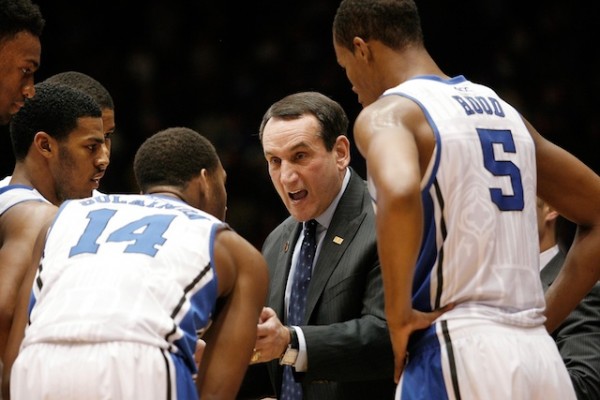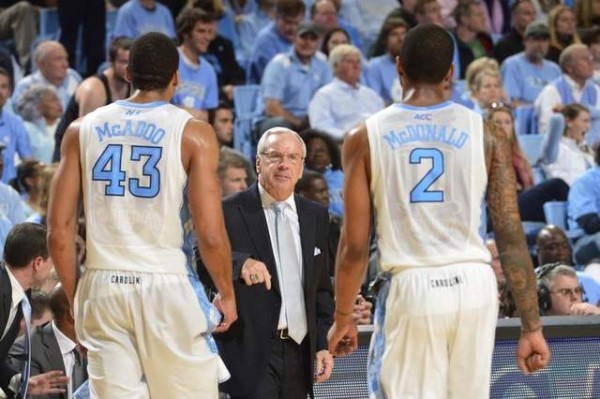Duke and North Carolina Making Adjustments After Slow ACC Starts
Posted by Brad Jenkins (@bradjenk) on January 19th, 2014After the second weekend of conference play, the ACC’s historically best two programs were in trouble. North Carolina was all alone at the bottom of the standings with an 0-3 record, and Duke wasn’t in much better shape at 1-2. Since then, both schools’ Hall of Fame coaches have made some changes to try and turn things around. At least for one week, each coach has managed to stop the bleeding. Duke has now won two straight games — over Virginia (69-65) and N.C. State (95-60) — since Mike Krzyzewski made some lineup and style changes; and North Carolina got its first ACC win Saturday over Boston College (82-71) in the Tar Heels’ only game of the week, featuring a starting lineup change from Roy Williams. Below we will look at the problems that each team was confronting, what the coaches did to address those issues, and consider the results and future expectations as a result.
-
Duke
Problems. The Blue Devils’ defense simply has not been good enough, ranking outside of Ken Pomeroy’s top 100 in adjusted efficiency for much of the season. Opponents were scoring easily in the paint — perhaps not surprising with Duke’s lack of interior size. But even worse was Duke’s inability to counter that deficiency with good perimeter pressure, and the lack of player communication and teamwork in defensive help situations. Offensively, the Blue Devils were not playing well as a unit, often falling into the habit of one-on-one play with little ball movement.
Adjustments. Krzyzewski and his staff decided to not only make a change in the starting lineup — inserting freshman Matt Jones — but they adjusted the entire rotation. As the TV commentators noted in each game, it was as if Duke was making hockey-style line changes in the first half. Both games followed the same pattern. About three minutes after the tip, five new Blue Devils checked in. A few minutes later, all the starters returned. Soon after that, it was another complete change. At that point in each contest — roughly 10-12 minutes in — all 11 scholarship players had logged at least three minutes of action. While the five-at-a-time substituting did not continue into the second half, Krzyzewski kept using his bench, with no player seeing more than 30 minutes in either contest. There was also a subtle stylistic change on each end of the court. The Blue Devils extended their defense further out than they had been, and they played more of a motion offense instead of mostly using set plays.
Results. In the postgame press conference following the N.C. State game, Krzyzewski addressed his rationale for playing more guys. He said that the team had learned in the first three ACC games that “conference games take even more of a toll on you.” He went on to say that it was particularly tough on this Duke team due to its lack of ruggedness and youth. Playing more people has kept his key players — Jabari Parker, Rodney Hood and Quinn Cook — well-rested. With a fresher team, Duke has been able to extend its defense, which resulted in 21 N.C. State turnovers on Saturday. The new offense has also produced better sharing of the ball. After assisting on 47 percent of made field goals in their first three ACC games, that number has risen to 56 percent in the last two. The combination of playing more personnel and encouraging unselfish offense appears to have helped the energy level at the defensive end as well. The big question is this, though – Can this new style work as well on an opponent’s home court? Duke will get a chance to take its new act on the road Wednesday evening at Miami.
North Carolina
Problems. The Tar Heels were in a huge offensive funk. Coming into the Boston College game, North Carolina was last in league games in offensive efficiency (84.1), in overall field goal shooting (36.1%), and in three-point shooting (18.8%). In their previous outing last weekend at Syracuse, the team only managed 45 points, the worst North Carolina output during Roy Williams’ entire tenure. After establishing himself as a star in pre-conference play, Marcus Paige had been knocked back in ACC action, averaging only 11 points per game and shooting an ice-cold 20 percent on three-point shots. He was not getting much help from fellow starting guard, freshman Nate Britt, who had been forced to play more minutes than he probably should have. Furthermore, there just seemed to be a lack of energy with the team. Perhaps all of the off-the-court issues — eligibility situations involving P.J. Hairston and Leslie McDonald along with ongoing academic fraud allegations involving student-athletes — had taken their toll on this young Tar Heels squad.
Adjustments. Williams decided to shake things up by adding two new starters in the Boston College game, inserting his lone senior, McDonald, in the backcourt, and junior Jackson Simmons up front. As he said in the postgame press conference, “We lost three in a row, you’ve got to try to do something. And I told them, I’m very open about it. I don’t know that Leslie [McDonald] done enough to deserve it, but I wanted to do something. Jackson [Simmons] plays harder than everybody else, and that’s the reason that he got the chance.” Williams was referring to that fact that McDonald had been in a shooting slump of his own, making only 3-of-17 three-pointers in his previous three ACC games. Additionally, the choice of Simmons may have been influenced by the performance of the other big man options against Syracuse the week before. In that contest against the Orange, the trio of Brice Johnson, Kennedy Meeks and Joel James combined for two points, six rebounds, and four turnovers in 35 minutes of play.
Results. On the surface, beating a weak Boston College squad by 11 points at home does not seem very impressive. But much like Duke’s first game after all of its changes — a narrow home win over Virginia — any win for a struggling team has merit. The Tar Heels dealt well with some adversity, outscoring the Eagles by 10 points in the last 10 minutes of play. While McDonald still did not shoot well, going 2-of-7 from three, he did make a crucial long jumper that pushed the margin to 10 with just over four minutes to go. Paige looked like the player he was earlier in the season, scoring 21 points and going 2-of-4 from beyond the arc. James Michael McAdoo also continued his improved play. After scoring 17 on Saturday, he now is averaging 16.0 PPG in his last five outings. If McDonald can join Paige and McAdoo as productive scorers, the Heels have a chance to be a decent offensive team despite the slow ACC start. Perhaps another starting assignment will help McDonald get there, and North Carolina will need a top notch effort to pull off a win in their next game on Monday night at Virginia.












































